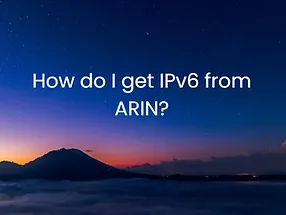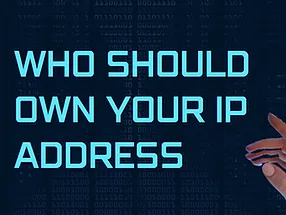
Let’s say you’re looking to write a letter to a friend who lives miles away.
What’s the first thing you need for that letter to reach the recipient? An address.
The same thing holds true for the Internet: to connect with other devices and receive data packets, any device that is part of a network, whether internal or external, requires a unique “house number.”
This is where the Internet Protocol address, sometimes referred to simply as IP, enters the picture.
The “IP” part stands for “Internet Protocol,” while the term “address” refers to a one-of-a-kind number associated with all of the activities you carry out online. However, the address you put on an envelope and an IP address look completely different in terms of appearance.
What is an Internet Protocol (IP)?
The Internet Protocol, known more commonly as IP, is a unique numeric identifier for machines in a given network. In other words, it is a collection of rules governing the data packets, data format, and datagrams sent across the Internet and local networks. This protocol is connectionless and datagram-oriented and may function without a centralized monitor or directory.
What is an Internet Protocol (IP) Address?
An Internet Protocol Address, often known as an IP address, is a one-of-a-kind numerical identification assigned to each device linked to a computer network that uses the Internet Protocol (IP) for communication. In plain English, this means that an IP address may be used to pinpoint the exact location of a computer or website inside a network. An example of an IP address: 193.17.2.3
Below, we’ll boil down the central systems and protocols to the bare bones to give you a better idea of what it is all about and how IP addresses work in the digital age. However, before we get down to the nitty-gritty, let’s take a look at the history and evolution of IP addresses.
How It All Started – The Origin
Voice and data communications have been dependent on the use of circuit switching ever since the invention of the telephone by Alexander Graham Bell in the latter half of the 19th century.
This was when every telephonic conversation revolved around a dedicated and end-to-end electronic connection between two communicating parties—from beginning to end.
As communication evolved, both communicating parties began to make use of computers, increasing the complexity of their communication. However, it wasn’t just about sending voices through the lines; the data needed greater capacity and an increased level of encryption.
It wasn’t until the early 1960s when computer scientist Paul Baran, who was working on a project for the Department of Defense at the Research and Development (RAND) in the United States, came up with Distributed Adaptive Message Block Switching—the foundation for packet switching.
The term “packet switching” became popular, which brings us to ARPANET—the founding father of Internet Protocol. The Department of Defense’s Advanced Research Projects Agency paid for and ran the ARPANET by utilizing Donald Davies and a few other individuals’ works on packet switching to create a network where multiple pairs of receivers and transmitters could share a single communication link. In other words, we can refer to it as a computer network’s foundation.
J. C. R. Licklider, who was in charge of ARPA’s Behavioral Sciences and Commanded and Control programs, came up with the idea for the “Intergalactic Computer Network.” He persuaded Ivan Sutherland, who was in charge of ARPA’s Information Processing Techniques Office, and Bob Taylor (NASA, who later worked for ARPA) that a computer network needed to be made.
Without wasting any time, Ivan Sutherland and Bob Taylor started making this network because they knew that computers provided by ARPA would make it easier for researchers at different companies and universities to share new software and other computer science studies quickly.
Remember Paul Baran from the RAND Corporation, whose idea of “Distributed Adaptive Message Block Switching” led Davies to create “packet switching,” which put Taylor in a tough spot? Well, he was looking into systems that could survive a nuclear war (Remember, this was in the 1960s).
In 1966, Taylor used this inside information to persuade Charles M. Herzfeld, who was in charge of the Advanced Research Projects Agency (ARPA) at the time, to fund his network project. Herzfeld took millions of dollars from a program to defend against ballistic missiles and put them in Taylor’s budget (Yes, a ballistic missile defense program pretty much funded the Internet).
Taylor put together a group of people to help him start his project by working on the standards for how users would be identified and verified, characters would be sent, and errors would be checked and resent—basically, network stuff. After everyone agreed, ARPA looked for bidders—140 to be exact, but since many thought the proposal was absurd, only 12 of the 140 bidders actually bid.
On April 7, 1969, BBN Technologies won the bid to build the network—led by Robert Kahn and Frank Heart. BBN’s network was made of Interface Message Processors (IMPs), the immature development of modern-day routers, which served as connections between local resources. At each site, IMPs were linked to leased lines using 56 Kbit/s telecommunication data sets (modems), while the host computers were linked to the IMPs by custom-made serial communication interfaces.
Moving forward to Network Control Program (NCP): The protocol stack that ran on the middle layers of the host computers on the ARPANET was called the Network Control Program. We told you it was a history of IP addresses, so the NCP used two port addresses to set up connections for two-way communication. Later, TCP/IP eventually replaced the NCP, which we’ll discuss below.
Time for the expansion of ARPANET: By March 1970, ARPANET was up and running at the headquarters of BBN in Cambridge, Massachusetts, on the East Coast of the United States. In June of 1970, there were nine IMPs connected to the ARPANET; by December 1970, there were thirteen; and by September 1971, eighteen. By the year 1981, 213 IMPs were connected once every 20 days.
Norway was the first country outside the United States to connect to the ARPANET. This happened in 1973 when a satellite link was set up across the Atlantic Ocean. At the same time, an IMP in London was linked to a terrestrial circuit. Over time, the heavy use of ARPANET worldwide began to show its technology’s limits. Researchers started looking for ways to improve the system.
Eventually, two American computer scientists, Vint Cerf of DARPA and Robert Kahn of BBN Technologies, came up with TCP/IP, which led to IP addresses and the Internet as we know it.
It is the early 1980s, and about 90% of the world’s population is unaware of ARPANET, IP addresses, and everything else that would be connected to the Internet in the years to come.
On January 1, 1983, ARPANET moved from its NCP protocol to TCP/IP, which was thought to be more versatile and powerful (we’ll get into that shortly); it came with an almost complete overhaul of the ARPANET infrastructure. This change paved the way for what we now refer to as the Internet, but in the short term, it meant jumping into a new set of complexities that needed to be worked out. Fortunately, the brightest brains in the world were already working on the problem.
Robert E. Kahn and Vinton Cerf are often called the “fathers” of TCP/IP, but they had a lot of help along the way. In the spring of 1973, Kahn and Cerf, who had worked together to make the NCP protocol, joined forces to make the next generation of ARPANET protocols.
By the summer of the following year, they had figured out how TCP/IP would work by changing how the ARPANET worked. Instead of the network being responsible for the reliability, it was given to the hosts using an internetwork protocol to hide the differences between local network protocols.
Cerf gave Louis Pouzin and Hubert Zimmermann much credit for their work on the CYCLADES network, which greatly impacted his and Kahn’s work. The transmission Control Program, the first part of TCP/IP, was the first program to use the new protocol. It came out in 1974.
At first, TCP was in charge of sending datagrams. As the protocol grew, however, other researchers began to suggest that these two tasks be split into separate layers. One of these researchers was Jonathan Postel from the Information Sciences Institute at the University of California. “We’re making a mess of designing Internet protocols by not following the layering rule,” said Postel.
Basically, he meant that TCP’s single-piece design would soon be too rigid and unable to scale well. This was why TCP was broken up into two protocols: TCP and Internet Protocol (IP).
Since the network is now called the Internet and is becoming increasingly commercial, something had to be done to organize all the new devices, each of which has its IP address. This is when groups like the American Registry for Internet Numbers (ARIN) get involved. Considering there are thousands of standards that engineers worldwide have carefully worked out to make different parts of the Internet work. Will they be around for a long time? The answer is yes, definitely.
Types of IP Addresses
There is a wide variety of IP address types, ranging from private IP addresses to IP addresses broadcast via an Ethernet network. They are all designed to perform the same job: ensuring that data packets are delivered to the address specified for them. Let’s discuss them in detail.
Public IP Addresses: An IP address that can be accessed directly over the Internet.
Private IP Address: A non-internet-facing IP address used in an internal network.
Static IP Address: A type of IP address that stays the same over time and doesn’t change.
Dynamic IP Address: An address that changes from time to time and is not always the same.
Dedicated IP Address: A type of website IP address that is unique for each website.
Shared IP Address: A type of website IP address shared between multiple domains.
Versions of IP Address
Generally, IP addresses come in two distinct forms, each visually distinguishable. They are similar in that each has a device component (for assignment to a certain computer) and a network component (used for IP routing). Here is the version of the IP address for the present (IPv4) and the future (IPv6).
IPv4 Addresses for the Present
The majority of websites now running utilize addresses that adhere to Internet Protocol Version 4, often known as IPv4. They are composed of 32 bits and refer to a 32-digit binary number. This wild numerical creature is often depicted as a mixture of 4 decimal figures with values ranging from 0 to 255, separated by points to ensure that it remains under control.
IPv6 Addresses for the Future
The availability of IPv4 addresses is rapidly decreasing due to the growing number of commonplace devices needing their own IP addresses. IPv6 has been introduced as the immediate successor to accomplish this goal, making it possible to have around 340 undecillion addresses (a figure with 37 zeros) for a virtually limitless supply of all future IP needs.
Classification Based on Operational Characteristics
The following are the subnetworks and classes of an IP address based on operational characteristics.
Broadcast Addressing: Rather than being assigned to a single host, a broadcast address is used to communicate simultaneously with all computers connected to a certain subnet. In other words, it enables information to be transmitted to all devices on a certain subnet instead of sending it to a particular machine. This service is accessible over IPv4 protocol.
Unicast Addressing: Mostly commonly used method for IP addressing, the term “unicast” refers to data transmission from one location in a network to another individually. It is an address that identifies a unique node on a network. This approach may be used for either the transmission or reception of data and is accessible in both IPv4 and IPv6 formats.
Multicast Addressing: Mainly used for one-to-many communication, a multicast address is a special kind of Internet Protocol (IP) address that labels a place on a network and is operated for multicasting data packets inside a network. Generally, the multicast group addresses are generally specified by their class D addresses, ranging from 224.0.0.0 to 239.255.255.255.
Anycast Addressing: An anycast address is allotted to a group of interfaces, most of which belong to separate routers. The routing protocol defines the distance between the two interfaces. For instance, when a data packet is meant to be sent to an anycast address, it is delivered to the interface with the address closest to the packet’s destination.
IP Address Security Threats
Cybercriminals might use various methods to access your IP address— social engineering and internet stalking being two of the most popular forms. If someone manages to get their hands on your IP address, they have the potential to cause a lot of trouble, from sending unwanted messages to assaulting the computer with full-on cyberattacks. Here are some common possibilities.
- Attackers may send you personalized spam.
- They may learn your geographic location.
- Restrict your activities to certain services.
- Prevent you from playing games online.
- Execute a Denial of Service (DoS/DDoS) attack.
- Gain access to PII (personally identifiable information).
- Frame you for creating national security threats.
- Sue you for several copyright infringements.
What can someone do with your IP address? Well, they can do a fair bit of damage, from flooding your email with spam to engaging in illicit actions using the identity of your device. Thankfully, there are ways to safeguard yourself, such as using antivirus software or a VPN. Nevertheless, you always have the option to merely change your IP address if all else fails, of course. Regardless of your chosen solution, a secure device ensures that your address will remain private.
So there you have it: everything you need to know about IP addresses. We hope this article helped broaden your understanding of the evolution of IP addresses, the distinctions between the different kinds of IP addresses, and how they serve as the foundation for device communications over the Internet and in local networks.
References:
https://www.akita.co.uk/ipv6-future-ip-addresses/
https://computer.howstuffworks.com/internet/basics/what-is-an-ip-address.htm
https://www.educba.com/how-do-ip-addresses-work/
https://www.security.org/vpn/what-can-someone-do-with-your-ip/
https://monovm.com/blog/types-of-ip-addresses/
https://www.geeksforgeeks.org/structure-and-types-of-ip-address/
https://www.guru99.com/types-of-ip-addresses.html
https://www.informit.com/articles/article.aspx?p=433329&seqNum=5
https://www.colocationamerica.com/blog/history-of-ip-address-part-3-rirs
https://www.ionos.com/digitalguide/server/know-how/what-is-an-ip-address/
https://www.kaspersky.com/resource-center/definitions/what-is-an-ip-address
https://wpastra.com/guides-and-tutorials/what-is-ip-address/




